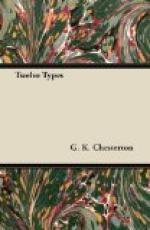It is in this quality of what may be called spiritual adventurousness that Scott stands at so different an elevation to the whole of the contemporary crop of romancers who have followed the leadership of Dumas. There has, indeed, been a great and inspiriting revival of romance in our time, but it is partly frustrated in almost every case by this rooted conception that romance consists in the vast multiplication of incidents and the violent acceleration of narrative. The heroes of Mr Stanley Weyman scarcely ever have their swords out of their hands; the deeper presence of romance is far better felt when the sword is at the hip ready for innumerable adventures too terrible to be pictured. The Stanley Weyman hero has scarcely time to eat his supper except in the act of leaping from a window or whilst his other hand is employed in lunging with a rapier. In Scott’s heroes, on the other hand, there is no characteristic so typical or so worthy of honour as their disposition to linger over their meals. The conviviality of the Clerk of Copmanhurst or of Mr Pleydell, and the thoroughly solid things they are described as eating, is one of the most perfect of Scott’s poetic touches. In short, Mr Stanley Weyman is filled with the conviction that the sole essence of romance is to move with insatiable rapidity from incident to incident. In the truer romance of Scott there is more of the sentiment of ‘Oh! still delay, thou art so fair’; more of a certain patriarchal enjoyment of things as they are—of the sword by the side and the wine-cup in the hand. Romance, indeed, does not consist by any means so much in experiencing adventures as in being ready for them. How little the actual boy cares for incidents in comparison to tools and weapons may be tested by the fact that the most popular story of adventure is concerned with a man who lived for years on a desert island with two guns and a sword, which he never had to use on an enemy.
Closely connected with this is one of the charges most commonly brought against Scott, particularly in his own day—the charge of a fanciful and monotonous insistence upon the details of armour and costume. The critic in the ‘Edinburgh Review’ said indignantly that he could tolerate a somewhat detailed description of the apparel of Marmion, but when it came to an equally detailed account of the apparel of his pages and yeomen the mind could bear it no longer. The only thing to be said about that critic is that he had never been a little boy. He foolishly imagined that Scott valued the plume and dagger of Marmion for Marmion’s sake. Not being himself romantic, he could not understand that Scott valued the plume because it was a plume, and the dagger because it was a dagger. Like a child, he loved weapons with a manual materialistic love, as one loves the softness of fur or the coolness of marble. One of the profound philosophical truths which are almost confined to infants is this love of things, not for their use or origin, but for




